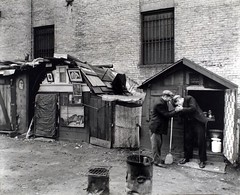 The University of Washington has a special online project, The Great Depression, that takes a hard look at Hoovervilles. For those not familiar with the term here is an explanation drawn from that website:
The University of Washington has a special online project, The Great Depression, that takes a hard look at Hoovervilles. For those not familiar with the term here is an explanation drawn from that website:
Homelessness followed quickly from joblessness once the economy began to crumble in the early 1930s. Homeowners lost their property when they could not pay mortgages or pay taxes. Renters fell behind and faced eviction. By 1932 millions of Americans were living outside the normal rent-paying housing market.
Many squeezed in with relatives. Unit densities soared in the early 1930s. Some squatted, either defying eviction and staying where they were, or finding shelter in one of the increasing number of vacant buildings.
And hundreds of thousands–no one knows how many–took to the streets, finding what shelter they could, under bridges, in culverts, or on vacant public land where they built crude shacks. Some cities allowed squatter encampments for a time, others did not.
The truly frightening thing is how much this resembles today. The BBC just released an in depth look at the rise of tent cities in the modern day U.S. The following description would not have been at all out of place in the headlines of Hoover’s era:
Just off the side of a motorway on the fringes of the picturesque town of Ann Arbor, Michigan, a mismatched collection of 30 tents tucked in the woods has become home – home to those who are either unemployed, or whose wages are so low that they can no longer afford to pay rent.
Conditions are unhygienic. There are no toilets and electricity is only available in the one communal tent where the campers huddle around a wood stove for warmth in the heart of winter.
Ice weighs down the roofs of tents, and rain regularly drips onto the sleeping campers’ faces.
Tent cities have sprung up in and around at least 55 American cities – they represent the bleak reality of America’s poverty crisis.
With unemployment the highest it’s been since the Great Depression, and state budgets being slashed left and right we should not be at all surprised by the societal fallout. After all, many of those budget cuts used to fund programs that cared for our nation’s poorest and most at risk members.
According to the BBC report there are currently about 5,000 people living in the dozens of homeless encampments that have sprung up over recent time. The largest one is Pinella’s Hope in central Florida which spans thirteen acres. With thirteen million unemployed Americans it is sad to say these numbers will probably grow.
Even in the best of times there is a stigma to homelessness for many people, one that exists even though the reasons for that homelessness are often beyond the individual’s control. This becomes more and more tragic as the number of people living on the streets increases.
The BBC piece closes by taking note of this:
The stark reality is that many of them are people who very recently lived comfortable middle-class lives.
For them, the economic downturn came too fast and many have been forced to trade their middle-class homes for lives in shelters, motels and at the far extreme, tented encampments.
Every day there are more stories about people who’ve become jobless due to austerity measures. The jump from jobless to homeless is a small one, and many end up on the streets every day.
In downTown: U.S.A. we looked at the homeless problem and possible ways to fix it, mostly centered on rehabilitation and educational programs. These are the exact programs under fire as the states tighten their belts, and the exact programs we need to support!
Image Source: John McNab on Flickr, used under it’s Creative Commons license









